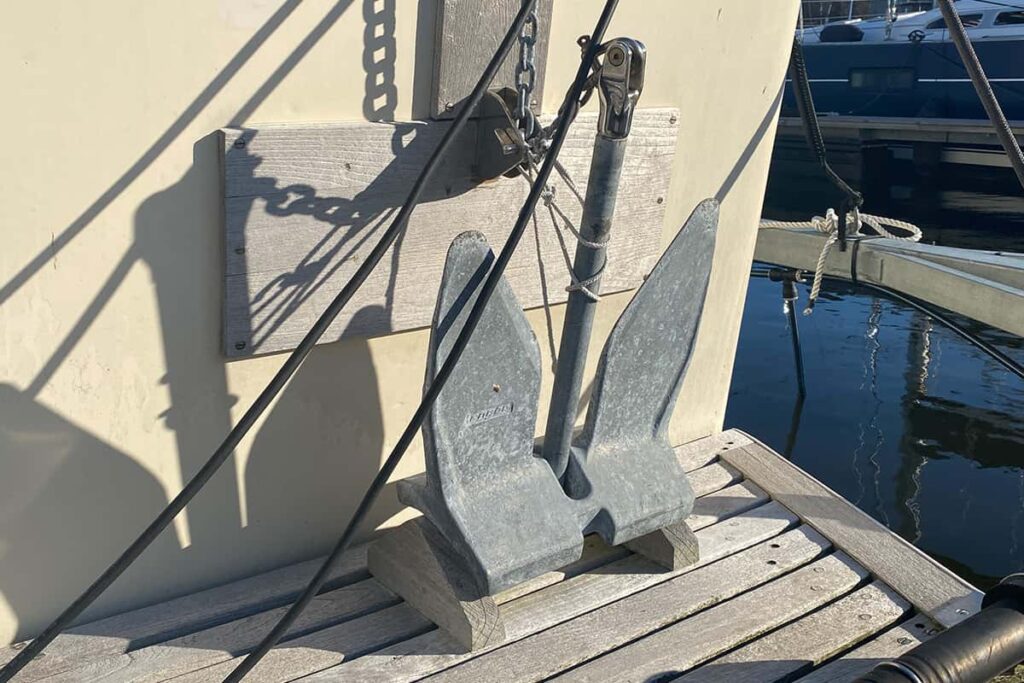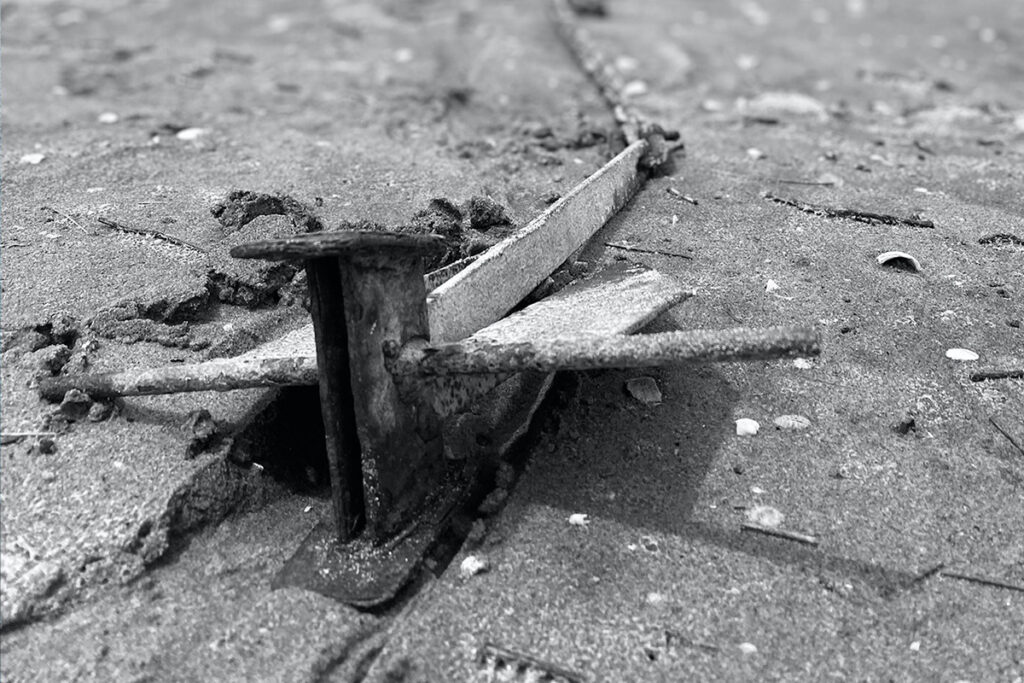Boating enthusiasts know that choosing the right anchor is crucial for a safe and enjoyable experience on the water. One popular type of anchor is the fluke style anchor, also known as the Danforth anchor. This type of anchor is designed to hold fast in a variety of seabeds, making it a versatile choice for boaters of all kinds.
But how does a fluke style anchor work? At its most basic level, a fluke style anchor uses a combination of weight and shape to dig into the seabed and hold the boat in place. The anchor’s two pointed flukes are designed to penetrate the seabed, while the flat, triangular shape of the anchor helps it to maintain its hold.

While the basic mechanics of a fluke style anchor are relatively simple, there are a number of factors that can affect its performance. These include the size and weight of the anchor, the length and type of chain or rope used to secure it, and the type of seabed where it will be used. Understanding these factors is key to choosing the right fluke style anchor for your vessel and ensuring a safe and enjoyable boating experience.
Anatomy of a Fluke Style Anchor
A fluke anchor is a type of anchor that is commonly used in small boats and other watercraft. It is designed to hold the boat in place by digging into the bottom of the water body. The anchor consists of several parts that work together to provide a secure hold. Here are the main components of a fluke anchor:
- Flukes: The flukes are the two pointed arms that dig into the bottom of the water body. They are shaped like a plow and are designed to penetrate the bottom and hold the anchor in place.
- Shank: The shank is the long, straight piece that connects the flukes to the anchor line. It is usually made of steel or other strong material and is designed to withstand the weight and force of the boat.
- Stock: The stock is a crossbar that sits perpendicular to the shank. Its purpose is to help the flukes dig into the bottom and prevent the anchor from flipping over.
- Anchor Line: The anchor line is the rope or chain that connects the anchor to the boat. It is usually made of nylon or other strong material and is designed to withstand the weight and force of the boat.
The fluke anchor works by using the weight of the boat to push the flukes into the bottom of the water body. As the flukes dig deeper, the stock helps to prevent the anchor from flipping over. The anchor line then pulls the shank and flukes in the opposite direction, creating a secure hold. When it is time to move the boat, the anchor line is released, and the fluke anchor is lifted out of the water.
Overall, the fluke anchor is a simple but effective tool for anchoring small boats and other watercraft. By understanding the anatomy of a fluke anchor, you can use it safely and effectively to hold your boat in place while you enjoy the water.

How Fluke Anchors Work
A fluke-style anchor is a type of anchor commonly used for small boats and watercraft. It is designed to hold the boat in place by digging into the bottom of the water body. Fluke anchors are lightweight and easy to handle, making them a popular choice among boaters.
The fluke anchor has a unique design that allows it to work effectively. The anchor consists of two flukes or blades that are curved and pointed at the tip. The flukes are attached to the shank, which is the long, straight part of the anchor that connects to the chain or rope. The shank is designed to pivot, allowing the flukes to dig into the bottom of the water body at an angle.
When the fluke anchor is dropped into the water, the flukes dig into the bottom and create a suction effect. As the boat pulls on the anchor, the flukes dig deeper into the bottom, increasing the holding power. The anchor is designed to release easily when it is time to move on, making it easy to retrieve and stow.
Fluke anchors work best in soft, muddy bottoms, and are not recommended for use in rocky or hard bottoms. They are also not recommended for use in strong currents or high winds, as they may not be able to hold the boat in place. It is important to choose the right size and style of anchor for your boat and the conditions you will be boating in.
Overall, fluke anchors are a reliable and efficient choice for small boats and watercraft. With their lightweight design and ease of use, they are a popular choice among boaters of all levels of experience.
Types of Fluke Anchors
Fluke anchors come in different types, each designed to suit specific boating needs. The most common types of fluke anchors include:
- Standard Fluke Anchor: This is the most common type of fluke anchor. It features two curved flukes that dig into the seabed as the anchor is lowered. The flukes are hinged to the shank, allowing them to adjust to the seabed’s contour for maximum holding power. Standard fluke anchors are ideal for boats under 30 feet long.
- Plow Fluke Anchor: This type of fluke anchor resembles a plow and is designed to dig deeper into the seabed than a standard fluke anchor. It has a sharp point that helps it penetrate hard or rocky bottoms. Plow fluke anchors are ideal for boats over 30 feet long.
- Lightweight Fluke Anchor: This type of fluke anchor is made of lightweight materials such as aluminum or plastic. It is ideal for small boats and dinghies and is easy to handle and stow.
- Grapple Fluke Anchor: This type of fluke anchor is designed for use in rocky or coral bottoms. It features multiple flukes that can grip onto rocks or other irregularities in the seabed.
When choosing a fluke anchor, it’s essential to consider the size of your boat, the type of seabed you’ll be anchoring in, and the weather conditions you’ll be facing. A fluke anchor that’s too small for your boat or the seabed conditions won’t provide adequate holding power, while one that’s too large may be difficult to handle and stow.
Pros and Cons of Fluke Anchors
Fluke anchors are a popular choice for boaters due to their lightweight design and ability to hold in a variety of seabeds. However, like any type of anchor, fluke anchors have their pros and cons.
Pros
- Lightweight design makes them easy to handle and store on board
- Fluke anchors can hold in a variety of seabeds, including sand, mud, and clay
- Due to their design, fluke anchors are less likely to damage the seabed compared to other types of anchors
- Fluke anchors are generally less expensive compared to other types of anchors
Cons
- Fluke anchors are not as effective in rocky or weedy seabeds
- In strong currents or high winds, fluke anchors may not hold as well as other types of anchors
- Fluke anchors require a longer scope (length of anchor rode) compared to other types of anchors to hold securely
- Due to their lightweight design, fluke anchors may not be suitable for larger boats or vessels in rough weather conditions
Overall, fluke anchors are a reliable and cost-effective choice for boaters in most conditions. However, it’s important to consider the specific conditions of your boating location and vessel before choosing an anchor type.
Tips for Using Fluke Anchors
Fluke anchors are one of the most popular types of anchors used by boaters. They are easy to use and can hold a boat in place in a variety of conditions. Here are some tips for using fluke anchors:
- Choose the right size anchor for your boat. A general rule of thumb is to use one pound of anchor weight for every foot of boat length. However, this can vary depending on the conditions you will be anchoring in.
- Make sure the anchor is properly set. To do this, slowly back up your boat while letting out the anchor line. Once you have let out enough line, the anchor should dig into the bottom and hold your boat in place.
- Use an anchor chain or rope to attach the anchor to your boat. This will help absorb shock and prevent the anchor from coming loose.
- Check the anchor periodically to make sure it is still holding your boat in place. If the anchor has come loose, you may need to reset it or move to a different location.
- Be mindful of the conditions you are anchoring in. Fluke anchors are best suited for sandy or muddy bottoms. They may not hold as well in rocky or weedy areas.
By following these tips, you can ensure that your fluke anchor will hold your boat in place and keep you safe while you are out on the water.
Where to Buy Fluke Style Anchors
If you’re looking to purchase a fluke style anchor after reading about how they work in the beginner’s guide you provided, there are several places you can check out.
Marine supply stores like West Marine and Fisheries Supply, as well as online retailers like Amazon and Defender, are great places to start. Additionally, outdoor retailers like Bass Pro Shops and Cabela’s often carry boating equipment, including anchors.
It’s important to keep in mind that availability may vary depending on your location and the specific brand or type of anchor you are looking for.
To ensure you’re getting the best deal, be sure to check reviews and compare prices before making a purchase. With a bit of research, you’ll be ready to set sail with your new fluke style anchor in no time!
- Sustainable and Luxurious: Discovering Split’s Yachting Paradise – April 26, 2024
- MarineTraffic vs VesselFinder: Which Is Better Vessel Tracking Service? – February 14, 2024
- Port Costs: A Comprehensive Guide to Port Dues and Fees for Cargo Ships – February 12, 2024




Leave a Reply